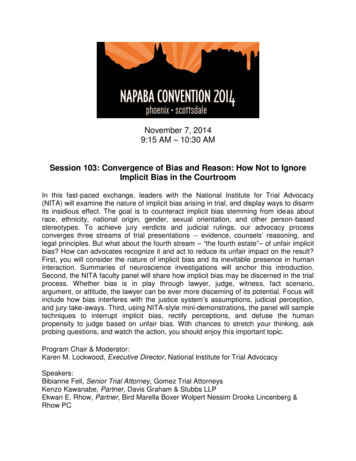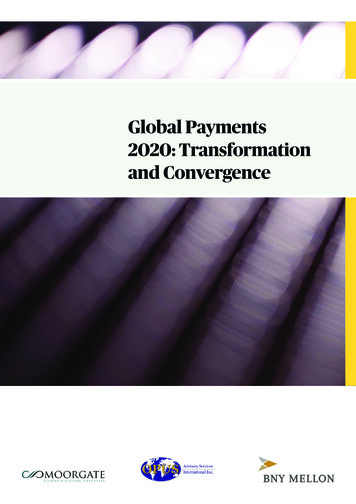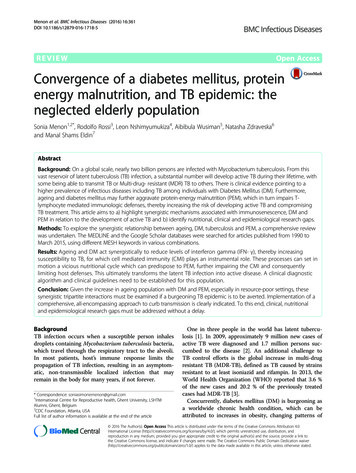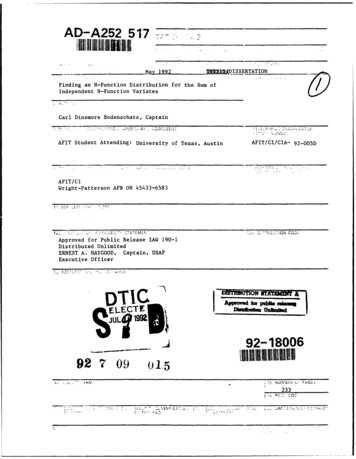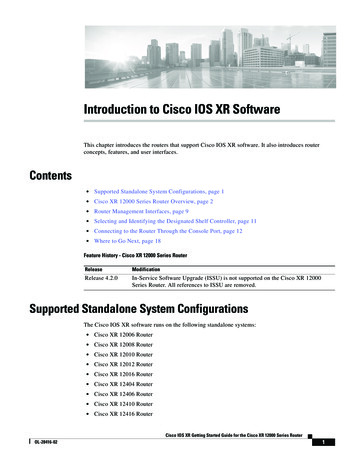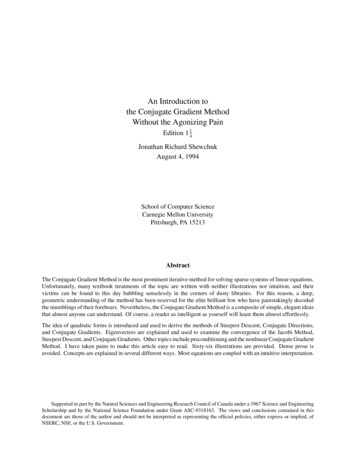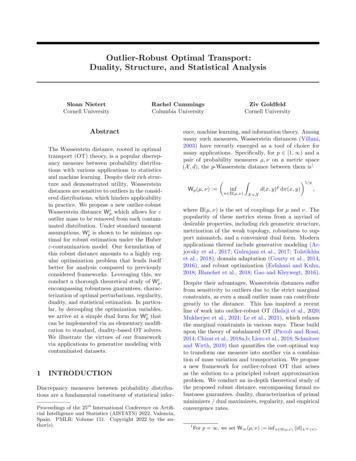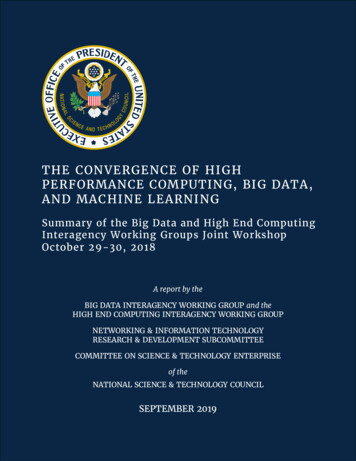
Transcription
THE CON VERGENCE OF HIG HPERFORMANCE COMPUTING, BIG DATA,AND MAC HINE LEARNINGSummary of the Big Data and High End ComputingInteragency Working Groups Joint WorkshopOctober 29-30, 2018A report by theBIG DATA INTERAGENCY WORKING GROUP and theHIGH END COMPUTING INTERAGENCY WORKING GROUPNETWORKING & INFORMATION TECHNOLOGYRESEARCH & DEVELOPMENT SUBCOMMITTEECOMMITTEE ON SCIENCE & TECHNOLOGY ENTERPRISEof theNATIONAL SCIENCE & TECHNOLOGY COUNCILSEPTEMBER 2019
Convergence of High Performance Computing, Big Data, and Machine Learning: Summary of 2018 WorkshopAbout the National Science and Technology CouncilThe National Science and Technology Council (NSTC) is the principal means by which the Executive Branch coordinatesscience and technology policy across the diverse entities that make up the Federal research and developmententerprise. A primary objective of the NSTC is to ensure that science and technology policy decisions and programs areconsistent with the President's stated goals. The NSTC prepares research and development strategies that arecoordinated across Federal agencies aimed at accomplishing multiple national goals. The work of the NSTC isorganized under committees that oversee subcommittees and working groups focused on different aspects of scienceand technology. More information is available at https://www.whitehouse.gov/ostp/nstc.About the Office of Science and Technology PolicyThe Office of Science and Technology Policy (OSTP) was established by the National Science and Technology Policy,Organization, and Priorities Act of 1976 to provide the President and others within the Executive Office of the Presidentwith advice on the scientific, engineering, and technological aspects of the economy, national security, homelandsecurity, health, foreign relations, the environment, and the technological recovery and use of resources, among othertopics. OSTP leads interagency science and technology policy coordination efforts, assists the Office of Managementand Budget with an annual review and analysis of Federal research and development in budgets, and serves as a sourceof scientific and technological analysis and judgment for the President with respect to major policies, plans, andprograms of the Federal Government. More information is available at https://www.whitehouse.gov/ostps.About the Networking and Information Technology Research and Development ProgramThe Networking and Information Technology Research and Development (NITRD) Program is the Nation’s primarysource of federally funded coordination of pioneering information technology (IT) research and development (R&D) incomputing, networking, and software. The multiagency NITRD Program, guided by the NITRD Subcommittee of theNSTC Committee on Science and Technology Enterprise, seeks to provide the R&D foundations for ensuring continuedU.S. technological leadership and meeting the needs of the Nation for advanced IT. The National Coordination Office(NCO) supports the NITRD Subcommittee and the Interagency Working Groups (IWGs) that report to it. More informationis available at https://www.nitrd.gov/about/.About the Big Data and High End Computing Interagency Working GroupsNITRD IWGs work to identify needs and opportunities across the Federal Government for R&D activities relevant tonetworking and IT and to offer opportunities for R&D coordination among agencies, academia, and the private sector.The NITRD Big Data Interagency Working Group (BD IWG) focuses on R&D to improve the management and analysis oflarge-scale data—including mechanisms for data capture, curation, management, processing, and access—to developthe ability to extract knowledge and insight from large, diverse, and disparate data sources.The NITRD High End Computing Interagency Working Group (HEC IWG) focuses on R&D to advance high-capability,revolutionary computing paradigms, and to provide the Nation with state-of-the-art computing, communication,software, and associated infrastructure to promote scientific discovery and innovation in the Federal, academic, andindustry research communities.More information is available at This workshop report was developed through contributions of the workshop committee, which included representativesfrom government, academia, and industry; NITRD Federal agency representatives; members of the Big Data and HighEnd Computing IWGs; and staff of the NITRD NCO. Sincere thanks and appreciation go out to all contributors.Copyright InformationThis document is a work of the U.S. Government and is in the public domain (see 17 U.S.C. §105). It may be freelydistributed, copied, and translated with acknowledgment to OSTP. Requests to use any images must be made to OSTP.Digital versions of this and other NITRD documents are available at https://www.nitrd.gov/publications/. Published inthe United States of America, 2019.
Convergence of High Performance Computing, Big Data, and Machine Learning: Summary of 2018 WorkshopAbbreviationsAIartificial intelligenceBDbig data and Big Data NITRD IWGCANDLECANcer Distributed Learning EnvironmentFPGAfield-programmable gate arraysDLdeep learningDOEDepartment of EnergyFPGAfield-programmable gate arrayGPUHECgraphic processing unitHigh-End Computing (NITRD IWG)HPChigh performance computingIWGInteragency Working GroupMLmachine learningNCINational Cancer InstituteNIHNational Institute of HealthNITRDNetworking and Information Technology Research and Development (Program)TBterabyte– iii –
Convergence of High Performance Computing, Big Data, and Machine Learning: Summary of 2018 WorkshopBackgroundThe high performance computing (HPC) and big data (BD) communities traditionally have pursuedindependent trajectories in the world of computational science. HPC has been synonymous withmodeling and simulation, and BD with ingesting and analyzing data from diverse sources, includingfrom simulations. However, both communities are evolving in response to changing user needs andadvancing technological landscapes. Researchers are increasingly using machine learning (ML) not onlyfor data analytics but also for modeling and simulation; science-based simulations are increasinglyrelying on embedded ML models not only to interpret results from massive data outputs but also tosteer computations. Science-based models are being combined with data-driven models to representcomplex systems and phenomena. There also is an increasing need for real-time data analytics, whichrequires large-scale computations to be performed closer to the data and data infrastructures, to adaptto HPC-like modes of operation. For example, in tactical mission support, where data comes from manydifferent sources and the computational environment is varied and geographically distributed, newcapabilities would include improved situational awareness and decision-making techniques such asimagery analysis to extract useful information from raw data; increased operating safety for aircraft,ships, and vehicles in complex, rapidly changing environments; and predictive maintenance and supplychain operations to predict the failure of critical parts, automate diagnostics, and plan maintenancebased on data and equipment condition. This and other use cases create a vital need for HPC and BDsystems to deal with simulations and data analytics in a more unified fashion.To explore this need, the NITRD Big Data and High-End Computing R&D Interagency Working Groupsheld a workshop, The Convergence of High Performance Computing, Big Data, and Machine Learning,on October 29-30, 2018, in Bethesda, Maryland. The purposes of the workshop were to bring togetherrepresentatives from the public, private, and academic sectors to share their knowledge and insightson integrating HPC, BD, and ML systems and approaches and to identify key research challenges andopportunities. Workshop participants represented a balanced cross-section of stakeholders involvedin or impacted by this area of research. The workshop agenda, list of attendees, webcast, and otherdetails are available at https://www.nitrd.gov/nitrdgroups/index.php?title HPC-BD-Convergence.Key TakeawaysThere are four key takeaways from the joint workshop on the convergence of HPC, BD, and ML: Data is growing at an unprecedented rate, and science demands are driving the convergence ofHPC, BD, and ML. It is not unusual to see petabytes of data being generated from one experimentalinstantiation. Data generation is no longer the research bottleneck it once was; it is now datamanagement, analysis, and reasoning that are the bottlenecks. There will be increased heterogeneity in future systems—including specialized processors such asgraphics processing units (GPUs) and field-programmable gate arrays (FPGAs)—as theperformance improvements provided by semiconductor scaling diminish. Systems will need to beflexible and have low latency at all levels to effectively support new use cases. In addition, newtools and benchmarks will be needed to understand the common issues across simulation (HPC),big data, and ML applications, because there is little reliable data available at present. The computing ecosystems of tomorrow will not look like the computing ecosystems of today.Future computing will likely involve combinations of edge, cloud, and high performance computing.To make this a seamless ecosystem, new programming paradigms,1 language compilers, and1In this document, the term “programming” is not limited to hand-coding but is meant to reflect all levels,including auto-code development that will result in flexible, low defect software.–1–
Convergence of High Performance Computing, Big Data, and Machine Learning: Summary of 2018 Workshopoperating and runtime systems will be needed to provide new abstractions and services. “Smartcomputing at the edge,” which involves intelligent data collection or data triage at the edge of thenetwork (near the source of the data), is expected to become increasingly important. More collaboration between the HPC, BD, and ML communities is needed for rapid and efficientprogress toward an ecosystem that effectively serves all three communities. While convergenceof data analytics and HPC-based simulation has seen some progress, the software ecosystemssupporting the HPC and BD communities remain distinctly different from one another, mainly dueto technical and organizational differences.Event SummaryThe workshop began with an overview of the current landscape and use cases, which was followed bypanel sessions and break-out discussions on the challenges and opportunities in three different aspectsof convergence: hardware, modes of operation, and software. The four workshop sessions aresummarized below.Current Landscape, Use Cases orApplications, and ChallengesThis session explored use cases from avariety of domains and applications toillustrate the current landscape, includingwhat is currently possible and what newopportunitiescouldemergewithconvergence. Presentations highlighted thepervasiveness and unprecedented scale ofdata being generated and illustrated thatconvergence is already underway. (See alsotwo recent convergence examples noted inthe sidebar and referenced attachments atthe end of this document.)The session presentations showed thatresearchers are working together closely tobuild predictive models that both integratea variety of experimental data and rely onML to help steer new simulations andexperiments. This form of convergenceenables researchers to have a more dynamicview of domain sciences and optimizesolutions with a significant reduction incompute requirements. However, there areseveral overarching challenges forconvergence of HPC, BD, and ML:Federal Collaborative Exascale HPC-BD-ML ProjectsOne example of HPC–BD-ML convergence is theDepartment of Energy (DOE) and National Institutes ofHealth (NIH) collaboration for the National CancerInstitute’s Cancer Distributed Learning Environment(CANDLE). CANDLE focuses on bringing together datafrom three major challenge areas (molecular, drugresponse, and treatment strategy) to improve cancerpatient outcomes. Each area involves distinct teamsof experts using diverse forms of data at differentscales, models, and simulations. The goal is to build a“single scalable deep neural network code that can beused to address all three challenges.”2 For moredetails on CANDLE, please see Attachment A.Another convergence example is the DOE–industryuniversity collaboration Exascale Deep Learning (DL)for Climate Analytics, where researchers from multipleorganizations used DOE’s Summit supercomputingsystem to identify extreme weather patterns using atrained DL model. HPC resources are essential forhandling the extreme data sizes and complexity in thisapplication. For more details on this project, pleasesee Attachment B. Access to highly curated data and compute resources. Although data is being generated at anunprecedented scale, there is a growing need for sound data management. Big data cannot beexploited for ML without well-curated, tagged datasets. Academia cannot keep pace with the2https://candle.cels.anl.gov/–2–
Convergence of High Performance Computing, Big Data, and Machine Learning: Summary of 2018 Workshoprapid advances made by industry without well-curated “gold standard” datasets and the scalesof computing and hardware necessary to perform these computations. Skilled workforce teams. A converged HPC–BD–ML environment inherently requires usingcollaborative research teams of domain scientists, data scientists, and software engineers. Manydomain scientists are unfamiliar with the new integrated technologies and require a team thatincludes software engineers and data scientists. This represents a shift from the traditionaldomain-based research teams consisting only of principal investigators and their graduatestudents; it also presents a new career path for data scientists and software engineers. Scientific reproducibility. Publication of scientific results should include the data and the softwarethat support the results so that other scientists can evaluate the rigor of an experiment designand the quality of data results, as well as be better able to reproduce results as a basis for furtherresearch. With convergence comes the opportunity to reexamine and improve current processesto make reproducibility a reality.Hardware Opportunities and ChallengesThis session examined the various aspects of hardware convergence. Discussions highlighted the factthat both simulation and data analytics depend on the ability of computer systems to perform denselinear algebra efficiently. Because systems are designed not for specific application areas but insteadfor data structures and methods, some aspects of integration are not as difficult as previouslyimagined. Evidence to support this includes machines that presently support simulation, dataanalytics, and ML projects, such as DOE’s Summit3 and the National Science Foundation–funded BlueWaters 4 and Frontera 5 supercomputers. Despite this, there are performance issues that need to beaddressed as hardware becomes more heterogeneous and flexible in response to changing user needs.Major hardware challenges for achieving convergence include: Interconnect efficiency at all levels: More efficient interconnects are needed to facilitate betterperformance across nodes, including intra-node, inter-node, fabric, and inter-fabric. This iscritical for large-scale applications. Today’s hardware options are not efficient when off-nodeoperations are required. Innovative tools and common end-to-end benchmark suites: Tools are needed to enable betterunderstanding of compute workloads, performance, and bottlenecks to ensure effective anduseful converged systems. There are no well-researched data, only anecdotes, to help identifycommon bottlenecks across simulation, big data, and ML applications. Power efficiency: The needs of the commercial sector will likely drive evolutionary approaches toimprove power efficiency. However, work is needed to develop innovative fine-grain powerefficiency techniques—distinct from evolutionary steps—for both processers and memory. Integrated memory: Both simulation and data analytics are memory-bound, and research isneeded for innovations in integrating memory and processing. Scalable file systems: HPC currently relies on file systems that do not scale well for newapplications such as ML. Research is needed to identify or develop file system technologies thatare effective for both HPC and ontera34–3–
Convergence of High Performance Computing, Big Data, and Machine Learning: Summary of 2018 Workshop Reliable networking: There is a need for a low-cost, end-to-end wide area network that is reliableand more fully automated. Balanced hardware development: As specialized hardware such as GPUs and FPGAs are beingemployed to improve performance—particularly for applications involving machine learning anddeep learning (DL)6—there is a need to balance R&D on different hardware aspects such as inputand output, latency and bandwidth, memory-type, and the heterogeneity of the processor(s).Modes of Operation Opportunities and ChallengesAs noted above, new instrumentation, enormous data rates, and ever-increasing computing platformcomplexity are driving new computational use cases and requirements. This session explored thedifferent modes of operation resulting from applications at the convergence of HPC, BD, and ML.Discussions highlighted that large-scale experiments, which have traditionally relied on localcomputing for data processing, are increasingly turning to HPC to produce timely results. Likewise,some ML or DL applications require HPC-scale resources for the training phases. Simulations are alsoreaching a scale and complexity such that a single application can take the form of a complex workflowof tasks and could benefit from using ML to automate those workloads. In addition, increased use ofsmart computing at the edge presents a use case where HPC, simulation, data analytics, and MLconverge in the workflow across a distributed infrastructure.Major challenges regarding modes of operation include: Scalable tools and capabilities for ML and large-scale data analysis: Large-scale complexsimulations rely on scalable numerical libraries and software that have been optimized overrecent decades. Innovations are needed to address the new world of ML and large-scale dataanalysis and may require changes in the underlying software stack. New user training and support: New users, whether from large-scale experiments or large-scaleML, are driving new HPC workloads. Services are needed to meet their needs, including supportfor a new and diverse set of software packages that are critical to their applications. In addition,more intuitive interfaces are needed for users who are not familiar with running applications atscale or interfacing with large-scale computing resources. New tools and services for data: Until recently, the HPC community has focused on simulation dataand data management services local to the HPC centers. But with the data-driven nature of manyof the new convergence applications, additional tools and services are needed for large-scale datamanagement, curation, retention, and access. Well-managed end-to-end solutions: Whether complex simulations requiring embedded ML orcomplex distributed workflows, new applications will benefit from well-managed end-to-endsolutions that reduce complexity and include reliable and elastic systems.Software Opportunities and ChallengesThis session explored the software stack and related convergence challenges and opportunities.Discussions revealed that the HPC community has embraced data analytics and that recent HPC systemsare well equipped to combine the predictive capabilities of simulation with the analytic and optimizationcapabilities of machine learning. With the recent adoption of deep neural networks for machinelearning, data analysis now has computational characteristics of traditional HPC workloads. Both HPC6In layman’s terms, machine learning refers to being able to train a computer to perform certain tasks withoutbeing explicitly programmed. DL is a type of machine learning where pattern recognition using stacked neuralnetworks is used. Neural networks are modeled after the human brain using sensors and several layers of nodes.–4–
Convergence of High Performance Computing, Big Data, and Machine Learning: Summary of 2018 Workshopand data analytic systems are adopting the use of accelerators such as GPUs to improve the performanceof individual computing nodes, and this trend will continue as a response to the limited gains of scaling.Major challenges regarding software include: System design: At the system level, there is a significant gap between how HPC systems aredesigned (tightly coupled collections of homogeneous nodes) versus BD systems (based on cloudcomputing data center architectures that consist of large numbers of loosely coupled andpossibly heterogeneous computing nodes). These structural differences, in turn, have led to a splitin the software stack that is both technological and cultural. The HPC stack relies on toolsdeveloped in government laboratories and academia. In contrast, the BD stack is much larger andmore varied and is often driven by open-source projects, with the main contributors beingcommercial entities. Edge Computing, or smart computing at the edge: This was identified as a rapidly emerging keyarea—one requiring new abstractions, concepts, and tools, including the software architecture,runtime systems, and perhaps even new programming languages. The emerging combination ofedge, cloud, and HPC will require software that makes these environments easier to program,debug, optimize, and interoperate in many future application areas. System management: Regardless of whether the computing is HPC or BD, launching massive jobswill require support to reduce job launch latency, monitor jobs in real time, and handle runtimenode and other failures. Common libraries: Most domain scientists and BD users do not have the expertise to handle thecomplexities of emerging hardware. Having a common set of libraries would allow nonexperts tomore easily use the systems, leaving the programming of these devices to experts.ConclusionThe NITRD joint BD–HEC IWG workshop explored challenges and opportunities for convergence of HPC,BD, and ML. From the presentations and discussions, a vision emerged of a rich computationalecosystem consisting of heterogeneous combinations of edge, cloud, and high performance computingsystems. This ecosystem would be flexible and be able to receive data from a variety of sources such asscientific and medical instruments, sensor networks, and security and infrastructure monitoring systems.It would have edge Internet of Things devices that would extract important features and convert data intoforms suitable for ingesting and storing in the cloud. Large-scale data analytics would run in the cloud,combining ingested data with stored databases. HPC systems would perform more computationallyintensive forms of analysis and optimization, as well as run simulations for predictive modeling.Such a rich computing environment could provide capabilities well beyond those of today’s isolatedsystems. For biomedical and clinical research and healthcare, it would enable the use of clinical,laboratory, and even molecular data for patients and for researchers. Data sources could include smarthealth applications where patient outcomes are connected to an evidence-based computed model,thereby putting data as a “digital first” asset in the healthcare system. The computing environmentwould allow scientific and medical researchers to solve problems with many degrees of freedom inways that allow data to inform models and simulations to build better models.Achieving this vision of a rich computing ecosystem will require new capabilities in hardware(computing, network, and storage); management modes of operation; and software. Providing trueconvergence among current and future computing environments presents many technical andorganization challenges, but it could provide capabilities in scientific research, national security,healthcare, and industry well beyond what is possible today.–5–
Convergence of High Performance Computing, Big Data, and Machine Learning: Summary of 2018 WorkshopAttachmentsA: CANDLE: Exascale Deep Learning & Simulation-Enabled Precision Medicine for CancerCANDLE (CANcer Distributed Learning Environment) is an exascale computing project whose goal is toenable the most challenging deep learning problems in cancer research to run on the most capablesupercomputers of the Department of Energy (DOE) and the National Institute of Health (NIH). It isdesigned to support three top challenges of the National Cancer Institute (NCI): understanding themolecular biology of key protein interactions, developing predictive models for drug response, andautomating the analysis and extraction of information from millions of cancer patient records todetermine optimal cancer treatment strategies.By tackling these exemplar cancer problems, CANDLE is building a core set of cross-cuttingtechnologies aimed at addressing common challenges at the convergence of HPC, big data, andartificial intelligence (AI) in science. For example, data processing and feature selection methodsimplemented in CANDLE allow experimental and derived datasets of multiple modalities to beharmonized and integrated in a machine learning framework. Representation learning methods inCANDLE compress very large input spaces such as raw simulation states into low dimensionalrepresentations that capture their scientific essence. Such encoded representations are then used tosteer simulation, provide synthetic validation data, and guide the acquisition of new experimentalsamples in cancer research workflows.CANDLE also aims to accelerate the many stages of DL workflows writ large, including featureengineering, parallel training, weight sharing in model populations, architectural search,hyperparameter optimization, and large-scale inference with uncertainty quantification. To acceleratelarge-scale model search experiments, ensembles, and uncertainty quantification, CANDLE features aset of DL benchmarks. These benchmarks are aimed at solving a problem associated with each of thecancer challenge problems, embody different DL approaches to problems in cancer biology, and areimplemented in compliance with CANDLE standards. Combined, these techniques will support theapplication of DL to more scientific domains and prepare them for existing HPC resources andforthcoming DOE exascale platforms.Implementations of CANDLE have been deployed on the DOE HPC systems Titan and Summit at OakRidge National Laboratory, Theta at Argonne National Laboratory, and Cori at the National EnergyResearch Scientific Computing Center at Lawrence Berkeley National Laboratory, as well as on the NIHBiowulf system. CANDLE computations use the full scale of these machines, using many thousands ofnodes in parallel, requiring tens of terabytes (TBs) of input/training data, and producing many TBs ofoutput data to analyze. In some cases, training data is harvested from petabytes of simulation data.CANDLE software builds on open source DL frameworks and the project engages in collaborations withDOE computing centers, HPC vendors, and the DOE Exascale Computing Project (ECP) to both leverageand drive new advances in HPC software. Future release plans call for supporting experimental design,model acceleration, uncertainty-guided inference, network architecture search, synthetic datageneration, and data modality conversion, as well as expanding into more scientific domain researchareas.For more details, see https://candle.cels.anl.gov/.–6–
Convergence of High Performance Computing, Big Data, and Machine Learning: Summary of 2018 WorkshopAttachment B: Exascale Deep Learning for Climate AnalyticsIn 2018, researchers from the DOE National Energy Research Scientific Computing Center at LawrenceBerkeley National Laboratory, a leading American technology company, the DOE LeadershipComputing Facility at Oak Ridge National Laboratory (ORNL), and a leading American universityachieved a major breakthrough when they successfully scaled a deep learning application on the DOESummit supercomputing system at ORNL using 27,360 GPUs. The team developed an innovativeconvolutional segmentation architecture to automatically extract pixel-level masks of extreme weatherpatterns such as tropical cyclones and atmospheric rivers, thus enabling the climate sciencecommunity to characterize the frequency and intensity of such events in the future. This project wasawarded the prestigious Gordon Bell Prize at the Supercomputing 2018 conference.The project overcame a number of technical challenges, most prominently in the area of storage anddata management where the general parallel file system was unable to sustain the data and metadatarates required. HPC resources were essential for handling the extreme data sizes and complex learnednetwork inherent in this climate application. The team processed a 20 TB climate dataset on 4560Summit nodes, obtaining 1.13 Exaflops/second (EF/s) peak, and 0.999 EF/s sustained performance inhalf-precision mode.The research team anticipates the co-design of future HPC systems to better support read-dominatedAI workloads. Future DL frameworks will need to support optimized ingest pipelines for scientificdatasets, supporting hybrid modes of data and model parallelism, and innovative methods for ensuringconvergence at extreme scales.For more details, see the paper from the IEEE Supercomputing 2018 conference proceedings, “ExascaleDeep Learnin
systems to deal with simulation s and data analytics in a more unified fashion. To explore this need, the NITRD Big Data and High-End Computing R&D Interagency Working Groups held a workshop, The Convergence of High Performance Computing, Big Data, and Machine



